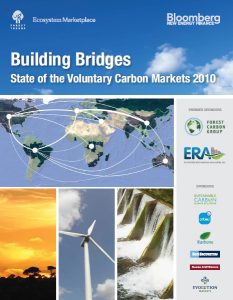Building Bridges, State of the Voluntary Carbon Markets 2010
By Kate Hamilton, Molly Peters-Stanley, and Thomas Marcello View PublicationClick to hear the Launch Event, moderated by Forest Trends CEO Michael Jenkins.
The year of 2009 was a tumultuous one for the voluntary carbon markets. First, the economic recession had a marked impact on the number of companies offsetting greenhouse gas (GHG) emissions. At the same time, unfolding new climate legislation in the United States led the actors in engaged in the voluntary carbon markets up with an interest in generating credits viable under new compliance programs through highs and lows.
Throughout the year, while voluntary carbon market transaction volumes remained relatively small, the marketplace thrived as an incubator of innovative protocols, registries, alliances, and project types. In the context of the regulated markets, the voluntary carbon markets proved they could be “the size of a mouse but have the roar of a lion.” For example, proposed federal climate legislation in the United States and federal offset programs in Australia referenced standards developed in the voluntary carbon markets. Also, reduced emissions from deforestation (REDD), a project type still exclusive to the voluntary carbon markets, took center stage at the international climate negotiations in Copenhagen at the end of 2009.
Last year many entities engaged in the voluntary carbon markets solely as a warm-up for the compliance big league. However, half the marketplace remains driven by “pure” voluntary buyers seeking to offset emissions. These buyers grew increasingly sophisticated, seeking specific credit types from specific locations. Despite the recession, numerous companies initiated offset programs or continued to commit to offsetting goals. However, the concept of offsetting has not lost its controversial edge and many stakeholders continued to emphasize the importance of reducing internal emissions before purchasing offsets.
Amidst the highs and lows, the marketplace continued to mature at a sprint pace, building infrastructure to ensure accountability and quality, incubating carbon market innovation and developing new GHG emissions reduction projects.

